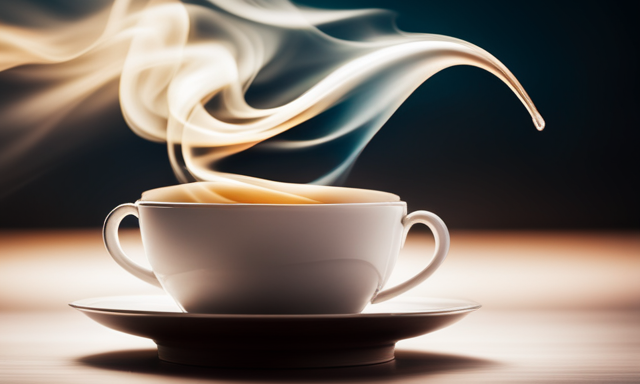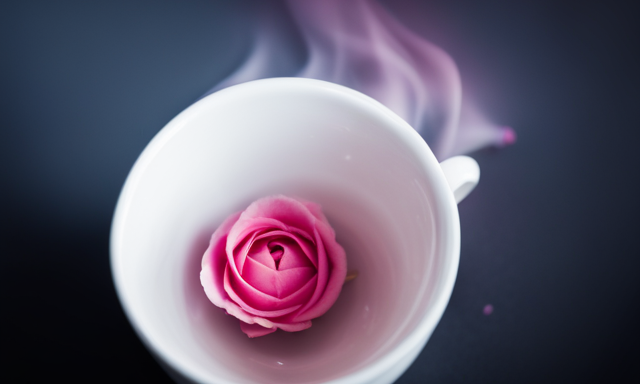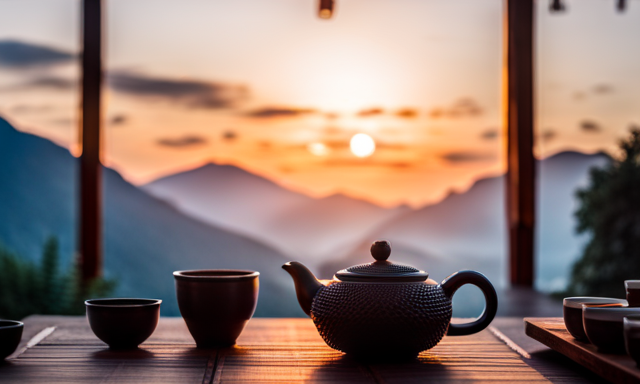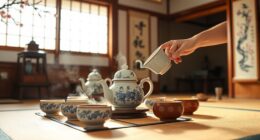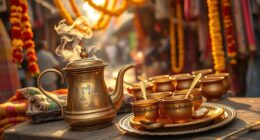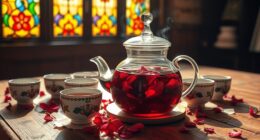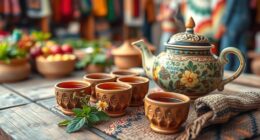Picture yourself indulging in a cup of oolong tea, experiencing the delightful sensation of warm and aromatic liquid enchanting your taste buds with a medley of flavors. That, my friend, is the essence of savoring oolong tea.
As an avid tea enthusiast, I have been captivated by the tantalizing taste of this unique brew. Oolong tea, known for its partially oxidized leaves, strikes the perfect balance between the boldness of black tea and the delicacy of green tea.
The oxidation process, carefully controlled by tea masters, lends oolong tea its distinct flavor profile. From the floral and fruity notes to the subtle hints of honey and roasted nuts, each sip unveils a new layer of complexity.
With a wide range of varieties to choose from, such as Tie Guan Yin and Da Hong Pao, oolong tea offers a world of flavors waiting to be explored. Join me on this journey as we delve into the delightful taste of oolong tea, and discover why it has become a beloved beverage for tea connoisseurs around the globe.
Key Takeaways
- Oolong tea has a complex taste that falls between black and green tea.
- It has a delicate and smooth texture, often described as velvety on the palate.
- The flavor profile of oolong tea varies based on the type and region of production, with floral, fruity, and sometimes nutty notes when steeped properly.
- The aroma of oolong tea is sweet and inviting, enhancing the overall tea experience.
What is Oolong Tea?
Oolong tea is a traditional Chinese tea that undergoes a unique oxidation process, which sets it apart from other types of tea. This oxidation process involves allowing the tea leaves to partially oxidize before they are heated or dried. The result is a tea with a distinct flavor profile that can vary greatly depending on the level of oxidation. Oolong tea can have flavors ranging from fruity and floral to nutty and roasted. The oxidation process plays a crucial role in developing these flavors, giving Oolong tea its unique taste.
Now let’s dive into the oxidation process and its impact on taste.
The Oxidation Process and its Impact on Taste
During the oxidation process, oolong tea undergoes a transformative journey that unveils a symphony of flavors, each note harmoniously blending to create a tantalizing dance on the palate. The impact of this oxidation process on the taste of oolong tea is profound. Here are four ways in which the oxidation process influences the flavor profile of oolong tea:
-
Aroma Enhancement: As the tea leaves oxidize, they release a captivating aroma that entices the senses and prepares the palate for the upcoming taste experience.
-
Flavor Development: The oxidation process brings out complex flavors in oolong tea, ranging from fruity and floral to nutty and toasty. These flavors are further enhanced by the level of oxidation, creating a wide array of taste sensations.
-
Balance and Depth: The oxidized oolong tea leaves achieve a delicate balance between sweetness, bitterness, and astringency, resulting in a tea with depth and complexity.
-
Smooth Mouthfeel: The oxidation process contributes to a smooth and velvety texture, making each sip of oolong tea a luxurious experience.
As the oxidation process shapes the taste of oolong tea, it sets the stage for exploring the fascinating flavor profile of this unique beverage.
Flavor Profile of Oolong Tea
Oolong tea is known for its smooth and balanced taste, making it a popular choice among tea enthusiasts.
It has delicate floral notes that add a pleasant aroma to the brew.
Additionally, oolong tea exhibits fruity and citrusy undertones, providing a refreshing and zesty flavor.
It also has earthy and roasty flavors that give it a unique and satisfying taste.
Smooth and Balanced Taste
When you take a sip of oolong tea, you’ll experience a harmonious blend of flavors that will leave you feeling truly satisfied. Oolong tea offers a smooth and balanced taste that sets it apart from other teas. Here are a few reasons why oolong tea is a great choice for tea enthusiasts:
-
Oolong tea benefits: This tea is known for its numerous health benefits. It can boost metabolism, aid in weight loss, promote heart health, and improve mental alertness.
-
Oolong tea vs other teas: Compared to green tea, oolong tea has a richer and more complex flavor. It is less bitter than black tea and has a lighter body. The unique processing method gives oolong tea a distinct taste that appeals to many tea lovers.
-
Floral notes: Transitioning into the next section about ‘floral notes in oolong tea,’ oolong tea also offers delicate floral undertones, adding a touch of elegance to its overall flavor profile.
Floral Notes in Oolong Tea
Indulge your senses in the delicate and elegant floral notes found in a cup of oolong tea, allowing you to savor each sip with pure bliss. Oolong tea showcases a captivating floral aroma that adds a touch of sophistication to its overall flavor profile. The floral notes in oolong tea can range from subtle and gentle to vibrant and robust, depending on the specific variety and brewing techniques used. To truly appreciate the floral nuances, it is important to brew oolong tea at the right temperature and for the appropriate duration. By doing so, you can unlock the full potential of the tea leaves and experience the delightful floral undertones that dance on your palate. Transitioning seamlessly into the next section, oolong tea also offers fruity and citrusy undertones that complement its floral character.
Fruity and Citrusy Undertones
With its tantalizing hints of ripe peaches and zesty lemons, the fruity and citrusy undertones of oolong tea transport you to a sun-drenched orchard, where each sip is like biting into a juicy, vibrant fruit.
These delightful flavors are a result of the tea leaves being partially oxidized, giving oolong tea a unique taste profile. To fully experience the fruity and citrusy flavors, it is important to steep oolong tea at the right temperature and for the right amount of time.
The optimal water temperature for steeping oolong tea is around 190-200°F (88-93°C), and the recommended steeping time is between 3-5 minutes. This allows the flavors to fully develop without becoming overpowering.
As I transition into the next section about ‘earthy and roasty flavors,’ it is important to note that oolong tea offers a complex and diverse range of tastes that cater to every palate.
Earthy and Roasty Flavors
Immerse yourself in the rich and comforting embrace of oolong tea’s earthy and roasty flavors. These flavors transport your senses to a cozy fireside retreat.
One of the defining characteristics of oolong tea is its earthy aroma. It is reminiscent of freshly fallen leaves on a crisp autumn day. The roasty notes add a layer of depth and warmth to the overall flavor profile.
The earthiness of oolong tea is a result of the tea leaves being semi-fermented and oxidized. This unique taste falls somewhere between the grassy freshness of green tea and the robustness of black tea.
Brewing techniques play a crucial role in enhancing these flavors. The water temperature should be around 195-205°F. This allows the leaves to unfurl and release their full potential.
As the earthy and roasty flavors caress your palate, get ready to explore the fascinating world of different varieties of oolong tea.
Different Varieties of Oolong Tea
Explore the diverse flavors of oolong tea and let your taste buds be captivated by the unique profiles of various oolong tea varieties. Here are three different oolong tea flavors that showcase the range of tastes you can expect.
-
Floral and Fragrant: Some oolong teas have a delicate floral aroma and taste. Imagine sipping tea that resembles a bouquet of flowers, with notes of orchid, jasmine, and lilac dancing on your tongue.
-
Fruity and Sweet: Other oolong teas offer a fruity and sweet experience. Picture yourself enjoying a cup of tea with hints of peach, apricot, or citrus, providing a refreshing and vibrant flavor.
-
Nutty and Toasty: Lastly, certain oolong teas boast a nutty and toasty character. These teas may remind you of roasted almonds or the warmth of a freshly baked biscuit.
Now that you know about the different oolong tea flavors and tasting notes, let’s move on to the next section and discover the art of brewing oolong tea.
Brewing Oolong Tea
Indulge in the art of steeping oolong tea, allowing the flavors to unfold and enchant your senses. Brewing oolong tea requires precision and attention to detail to achieve the perfect cup.
Start by selecting high-quality oolong tea leaves from the best oolong tea brands, ensuring a rich and complex flavor profile.
The water temperature and steeping time are crucial in bringing out the unique characteristics of oolong tea. For a lighter oolong, use water around 176°F (80°C) and steep for 2-3 minutes, whereas a darker oolong benefits from water at 194°F (90°C) and a longer steeping time of 3-5 minutes.
Experiment with different brewing techniques, such as gongfu style or western style, to find your preferred method.
Once you have mastered the art of brewing oolong tea, you can explore the delightful world of pairing it with food.
Pairing Oolong Tea with Food
Enhance your culinary experience by discovering the harmonious symphony of flavors that arise when pairing oolong tea with various delectable dishes.
-
Indulge in the rich, buttery taste of a warm slice of apple pie, perfectly complemented by the smooth and slightly floral notes of oolong tea.
-
Experience the delightful contrast of a tangy lemon tart alongside the earthy and nutty undertones of oolong tea.
-
Savor the velvety texture and sweet, creamy flavors of a vanilla bean panna cotta, balanced by the gentle and fruity hints of oolong tea.
-
Delight in the pairing of a decadent dark chocolate mousse with the robust and toasty flavors of oolong tea.
-
Explore the intricate layers of a delicate lavender-infused macaron, accentuated by the delicate and floral nuances of oolong tea.
Pairing oolong tea with desserts allows for a delightful exploration of its flavor profiles, creating a truly memorable dining experience.
As we move on to discuss the health benefits of oolong tea, let’s delve into its many remarkable qualities.
Health Benefits of Oolong Tea
Sipping on a cup of oolong tea can contribute to your overall well-being, offering a range of health benefits for your body and mind. Oolong tea is rich in antioxidants, which combat cellular damage caused by free radicals. These antioxidants reduce the risk of chronic diseases such as heart disease and cancer. Oolong tea also boosts metabolism and aids in weight loss by increasing fat oxidation and improving energy expenditure. To fully enjoy the health benefits, proper brewing techniques are important. Water temperature and steeping time bring out the tea’s delicate flavors and medicinal properties. Now, let’s explore where to buy oolong tea and indulge in its goodness.
Where to Buy Oolong Tea
When it comes to enjoying the health benefits of Oolong tea, it’s essential to know where to buy it. Here are some buying tips to help you make the best choice:
- Research reputable tea vendors: Look for well-established companies known for their quality Oolong tea.
- Compare prices: Check both online and in-store options to find the best deals.
- Read customer reviews: Take advantage of the experiences shared by other tea enthusiasts to make an informed decision.
- Consider freshness: Opt for tea that is labeled with a specific harvest date to ensure you’re getting the freshest leaves.
When it comes to buying Oolong tea, there are pros and cons to both online and in-store shopping. Online shopping offers convenience and a wider selection, while in-store shopping allows you to examine the tea leaves firsthand.
Now that you know where to buy Oolong tea, let’s explore how to store it properly.
How to Store Oolong Tea
To ensure the optimal flavor and quality of your Oolong tea, it’s crucial to store it properly. There are a few key storing methods that will help preserve the freshness of your tea.
First, it’s important to keep your Oolong tea away from moisture, light, and strong odors. Store it in an airtight container, such as a glass jar or a tin, in a cool and dark place. Avoid storing it in the refrigerator or freezer, as the fluctuating temperatures can affect the flavor.
Additionally, make sure to keep your tea away from spices or other strong-smelling foods, as Oolong tea can easily absorb odors.
By following these storing methods, you can ensure that your Oolong tea stays fresh and delicious for as long as possible.
Now, let’s move on to answering some FAQs about Oolong tea.
FAQs about Oolong Tea
One might be curious about the flavor profile of this exquisitely crafted tea variety. Oolong tea is known for its complex and unique taste that falls somewhere between black and green tea. It has a delicate and smooth texture that is often described as velvety on the palate. The flavor can vary depending on the type of oolong tea and the region it is produced in.
When steeped properly, oolong tea offers a delightful experience with its floral, fruity, and sometimes nutty notes. The aroma is often described as sweet and inviting, making it an enjoyable tea to savor. Oolong tea production involves a specific process of withering, oxidation, and firing, which contributes to its distinct flavor profile.
To fully appreciate the flavors of oolong tea, it is important to follow the recommended steeping time, which can range from 3 to 5 minutes. Steeping for too long may result in a bitter taste, while a shorter steeping time may not bring out the full range of flavors. So, take your time and indulge in the wonderful taste of oolong tea.
Frequently Asked Questions
What are the different types of oolong tea and their unique flavors?
There are various types of oolong tea with unique flavors. Some popular ones include Tie Guan Yin, Da Hong Pao, and Oriental Beauty. Each type has its own distinct taste profile, ranging from floral and fruity to toasty and nutty. To bring out the flavors, different brewing methods can be used, such as gongfu style or western style brewing.
Can oolong tea be brewed using a tea bag?
Yes, oolong tea can be brewed using a tea bag. It is a convenient option for those who want to enjoy the benefits of oolong tea without the hassle of loose tea leaves.
Does oolong tea contain caffeine?
Yes, oolong tea contains caffeine. It is known for its unique combination of fruity and woody flavors. Oolong tea also offers numerous health benefits, including promoting weight loss, improving heart health, and boosting mental alertness.
Can oolong tea be served hot and cold?
Yes, oolong tea can be served hot or cold. When served hot, it has a rich, smooth flavor profile with floral and fruity notes. When served cold, it’s refreshing and brings out the tea’s natural sweetness.
Are there any potential side effects or risks associated with consuming oolong tea?
I must mention that while oolong tea offers potential health benefits, there are some potential side effects to be aware of. It is important to consume oolong tea in moderation and stay within the recommended daily intake.
Conclusion
What does oolong tea taste like?
Oolong tea offers a unique and captivating taste experience. Its flavor profile is influenced by the oxidation process, resulting in a harmonious blend of floral, fruity, and toasty notes. Each type of oolong tea has its own distinct characteristics, providing a flavor to suit every palate.
Brewing oolong tea requires attention to detail, but the effort is rewarded with a rich and complex cup of tea.
In conclusion, oolong tea is a delightful beverage that not only offers a wide range of health benefits but also adds a wonderful addition to any tea lover’s collection. So why not indulge in a cup and savor the exquisite taste of oolong tea?

